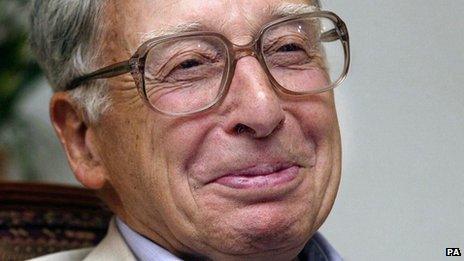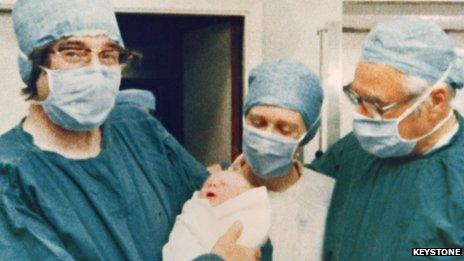Obituary: Robert Edwards, test-tube baby pioneer
- Published

"The most important thing in life is having a child," said the late Prof Sir Robert Edwards.
He was one of the pioneers of in vitro fertilisation, known as IVF, alongside his colleague Dr Patrick Steptoe.
Sir Robert, who has died aged 87, was born in Batley outside Leeds in September 1925.
World War II and service in the British Army delayed his eventual emergence in the scientific world.
In 1951 he graduated from the University of Bangor in Wales and then completed his doctorate at the University of Edinburgh in 1955. It was at Edinburgh that he met his wife Ruth.
Around this time he began to work on the processes of fertilisation - that critical moment when a man's sperm and a woman's egg join to create new life.
Early progress
Animal studies had shown that it was possible to fertilise an egg in a laboratory instead of inside the body.
The team of Dr Steptoe and Prof Edwards were trying to achieve the same results in people.
It took until 1968 for the first glimmers of success.
They fertilised an egg, which then began to develop and reached the blastocyst stage after five to six days.
Prof Edwards said: "I'll never forget the day I looked down the microscope and saw something funny in the cultures.
"I looked down the microscope and what I saw was a human blastocyst gazing up at me. I thought, 'We've done it'".
However, there would be another decade of trials and tribulations before the first test-tube baby.
Their work was refused funding by the UK's Medical Research Council in 1971 and they had to rely largely on private donations to continue their work.
It was also vigorously opposed by groups including the Catholic Church and scientists were concerned about abnormalities in any babies born through these procedures.
The Brown family
There were many failed attempts, the first pregnancy was ectopic, but one of the childless couples treated were Lesley Brown and her husband John.
They had been trying to conceive for nine years, but now she was pregnant.
The media storm was intense.
"We were concerned that she would lose the baby, the foetus, because the press were chasing Mrs Brown all over Bristol where she lived," said Prof Edwards in 2008.
"So, secretly Patrick Steptoe hid the mother in his car and drove her to his mother's house in Lincoln - the press didn't know where she was."

Robert Edwards, Jean Purdy with Louise Brown and Patrick Steptoe
In 1978, at Oldham and District General Hospital, a tiny baby was introduced to the world.
The birth of Louise Brown, the first test tube baby, changed the world forever.
Being infertile was no longer a guaranteed barrier to having a child.
Robert Edwards and Patrick Steptoe would then set up the first IVF clinic - Bourn Hall in Cambridgeshire - in 1980.
The opposition to IVF lessened with time and the procedure is now commonplace.
By 2012, more than five million children had been born through assisted reproductive techniques around the world.
Dr Patrick Steptoe died in 1988.
It was a long wait for a Nobel Prize, which was awarded to Prof Edwards for medicine in 2010. A knighthood followed the year later.
He was one of the giants of science in the 20th Century and pioneered the techniques which have given children to millions of couples.
- Published10 April 2013
- Published20 June 2012
- Published11 June 2011
- Published10 December 2010
- Published4 October 2010